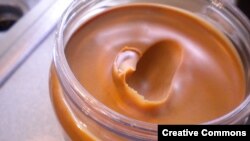Detecting early stage Alzheimer’s disease may be as easy as sniffing a dollop of peanut butter.
Researchers at the University of Florida’s McKnight Brain Institute Center for Smell and Taste came up with the idea to test smell sensitivity because it can be “one of the first things to be affected in cognitive decline.” Also, the ability to smell is associated with the first cranial nerve.
Jennifer Stamps, a graduate student at the University of Florida came up with the idea for using peanut butter because it is a “pure odorant” that is only detected by the olfactory nerve and is easy to access.
In the study, test subjects sat down with a clinician, 14 grams of peanut butter — which equals about one tablespoon — and a metric ruler. The patient closed his or her eyes and mouth and blocked one nostril. The clinician opened the peanut butter container and held the ruler next to the open nostril while the patient breathed normally. The clinician then moved the peanut butter up the ruler one centimeter at a time during the patient’s exhale until the person could detect an odor. The distance was recorded and the procedure repeated on the other nostril after a 90-second delay.
The clinicians running the test did not know the patients’ diagnoses, which were not usually confirmed until weeks after the initial clinical testing.
The scientists found that patients in the early stages of Alzheimer’s disease had a dramatic difference in detecting odor between the left and right nostril — the left nostril was impaired and did not detect the smell until it was an average of 10 centimeters closer to the nose than the right nostril had made the detection in patients with Alzheimer’s disease. This was not the case in patients with other kinds of dementia; instead, these patients had either no differences in odor detection between nostrils or the right nostril was worse at detecting odor than the left one.
Of the 24 patients tested who had mild cognitive impairment, which sometimes signals Alzheimer’s disease and sometimes turns out to be something else, about 10 patients showed a left nostril impairment and 14 patients did not. The researchers said more studies must be conducted to fully understand the implications.
“At the moment, we can use this test to confirm diagnosis,” Stamps said. “But we plan to study patients with mild cognitive impairment to see if this test might be used to predict which patients are going to get Alzheimer’s disease.”
The results of the study were published in the Journal of Neurological Sciences.
Researchers at the University of Florida’s McKnight Brain Institute Center for Smell and Taste came up with the idea to test smell sensitivity because it can be “one of the first things to be affected in cognitive decline.” Also, the ability to smell is associated with the first cranial nerve.
Jennifer Stamps, a graduate student at the University of Florida came up with the idea for using peanut butter because it is a “pure odorant” that is only detected by the olfactory nerve and is easy to access.
In the study, test subjects sat down with a clinician, 14 grams of peanut butter — which equals about one tablespoon — and a metric ruler. The patient closed his or her eyes and mouth and blocked one nostril. The clinician opened the peanut butter container and held the ruler next to the open nostril while the patient breathed normally. The clinician then moved the peanut butter up the ruler one centimeter at a time during the patient’s exhale until the person could detect an odor. The distance was recorded and the procedure repeated on the other nostril after a 90-second delay.
The clinicians running the test did not know the patients’ diagnoses, which were not usually confirmed until weeks after the initial clinical testing.
The scientists found that patients in the early stages of Alzheimer’s disease had a dramatic difference in detecting odor between the left and right nostril — the left nostril was impaired and did not detect the smell until it was an average of 10 centimeters closer to the nose than the right nostril had made the detection in patients with Alzheimer’s disease. This was not the case in patients with other kinds of dementia; instead, these patients had either no differences in odor detection between nostrils or the right nostril was worse at detecting odor than the left one.
Of the 24 patients tested who had mild cognitive impairment, which sometimes signals Alzheimer’s disease and sometimes turns out to be something else, about 10 patients showed a left nostril impairment and 14 patients did not. The researchers said more studies must be conducted to fully understand the implications.
“At the moment, we can use this test to confirm diagnosis,” Stamps said. “But we plan to study patients with mild cognitive impairment to see if this test might be used to predict which patients are going to get Alzheimer’s disease.”
The results of the study were published in the Journal of Neurological Sciences.







